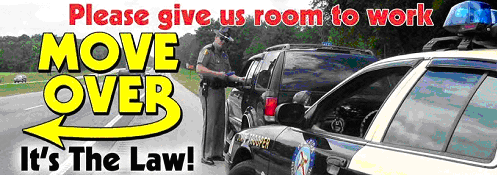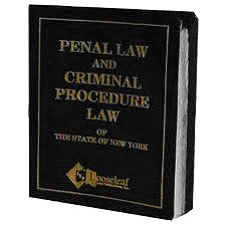
On January 1, 2011 the State of New York enacted a new law requiring that motorists exercise extreme caution when passing emergency vehicles that are stopped in or on the side of the road. The law, New York Vehicle and Traffic Law § 1144-a, commonly known as the “move over” law, was enacted as the “Ambrose-Searles Move Over Act.” The act is named in honor of New York State Trooper Robert W. Ambrose and Onondaga County Sheriff Deputy Glenn M. Searles, who were both killed in the line of duty while their patrol vehicles were stopped on the side of the road.
No one can object to the intent of this law – keeping public safety officers safe. Indeed, very recently New York State Trooper Kevin Dobson was killed when struck by a car while issuing a traffic ticket in Buffalo, New York. The move over law attempts to address this tangible risk that face all emergency service workers when performing their duties on a roadway.
New York VTL § 1144-a move over law is aggressively enforced by the New York State Police. There has been a lot of press coverage about the law and method and fairness of enforcement. Moreover, it is a moving violation that accrues points to a driver’s license which could cause an insurance increase. This page gives the entire text of the law, a technical breakdown, and the defenses available to a motorist when charged with this infraction. The statute verbatim is as follows:
NY VTL § 1144-a. Operation of vehicles when approaching a parked, stopped or standing authorized emergency vehicle
1144-a. Operation of vehicles when approaching a parked, stopped or standing authorized emergency vehicle. Every operator of a motor vehicle shall exercise due care to avoid colliding with an authorized emergency vehicle which is parked, stopped or standing on the shoulder or any portion of such highway and such authorized emergency vehicle is displaying one or more red or combination red and white lights pursuant to the provisions of paragraph two of subdivision forty-one of section three hundred seventy-five of this chapter. For operators of motor vehicles on parkways or controlled access highways, such due care shall include, but not be limited to, moving from a lane which contains or is immediately adjacent to the shoulder where such authorized emergency vehicle displaying one or more red or combination red and white lights pursuant to the provisions of paragraph two of subdivision forty-one of section three hundred seventy-five of this chapter is parked, stopped or standing to another lane, provided that such movement otherwise complies with the requirements of this chapter including, but not limited to, the provisions of sections eleven hundred ten of this title and eleven hundred twenty-eight of this title.
Elements of the move over statute
In order for a violation to occur, an emergency vehicle must be (1) stationary on a highway shoulder or the road itself; (2) operating at least one red or combination red / white lights. When these 2 conditions are met, the motorist is under a duty to “exercise due care to avoid colliding with an authorized emergency vehicle.”
The statute then goes on to create an affirmative duty when driving on a highway to, at a minimum, “mov[e] from a lane which contains or is immediately adjacent to the shoulder where such…emergency vehicle [is].” However, despite this requirement, a driver is nonetheless prohibited from moving over unless the movement “complies with the requirements of [VTL chapter 11], including, but not limited to…[VTL § 1110 and VTL § 1128] of this title.”
In other words, when on a highway a motorist must move over at least 1 lane, but only if it is safe to do so and in compliance with all of the rules / laws of the road; but specifically NY VTL § 1110(a) & NY VTL § 1128.
Defenses to NY VTL § 1144-a move over law
As one can clearly see, the statute is written in such a way that leaves it open to numerous exceptions and defenses. To further analyze NY VTL § 1144-a, we must take a closer look at NY VTL § 1110(a) & NY VTL § 1128.
New York VTL § 1110 requires drivers to obey traffic control devices (i.e., road markings, lines, signs, etc.). So for example if a motorist were required to cross over a double yellow line in order to comply with VTL § 1144-a move over requirement, a motorist would be prohibited from moving over.
New York VTL § 1128 is the law of “lane changes.” The most germane portion of the statute prohibits a motorist from changing lanes “until the driver has first ascertained that such movement can be made with safety.” This provides the greatest area for defense against the charge.
The first thing to note is that NY VTL § 1128 is written subjectively, not objectively. In other words, it does not say that the driver can change lanes ‘when reasonably prudent,’ but can only do so when the “driver…first [ascertains] that…movement can be [safely made].” The wording of the statute implies that the burden is on the driver, from the driver’s viewpoint, of when it is safe to move over, not on an “objectively reasonable” standard when an “objectively reasonable prudent person” would realize that it were safe to change lanes.
A second prong to defense of violation of New York VTL § 1144-a under New York Vehicle and Traffic Law § 1128 is that the driver must “first [ascertain]” that it is safe to move over. In other words, it could have been totally safe to move over, but there was not enough time for the motorist to realize this.

Affirmative defenses of justification found in the Penal Code of New York
Affirmative defenses are found in New York’s Penal Law. In essence, an affirmative defense is a legally sufficient excuse for failure to comply with a law. The most applicable defense would be the “necessity” defense.
New York Penal Law § 35.05 holds that conduct which would otherwise constitute an offense is justifiable when:
“Such conduct is necessary as an emergency measure to avoid an imminent public or private injury which is about to occur by reason of a situation occasioned or developed through no fault of the actor, and which is of such gravity that, according to ordinary standards of intelligence and morality, the desirability and urgency of avoiding such injury clearly outweigh the desirability of avoiding the injury sought to be prevented by the statute defining the offense in issue.”
In other words, it is necessary to fail to adhere to the statute when traffic is such that anyone with normal intelligence could see that by doing so would cause an accident. In such a situation, it is necessary to maintain your lane and not move over. In effect, the necessity defense is “written into” the move over statute itself by proscribing that the lane change can be done safely.